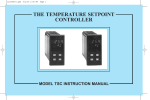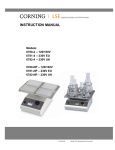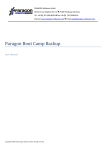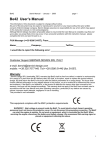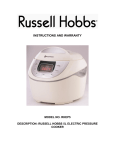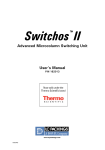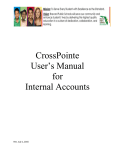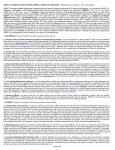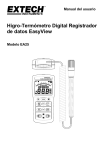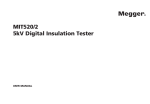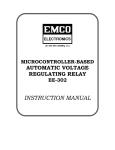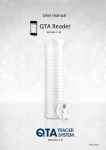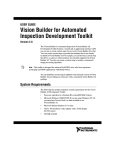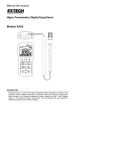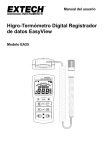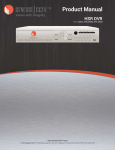Download West 4400 manual - Instrumentation Central
Transcript
PROG 1 4 -DIN SETPOINT PROGRAMMER Operator's Manual 59215-1 PREFACE This manual is intended for use in support of day-to-day operation of the 41 -DIN Setpoint Programmer. For information on installation, commissioning, configuration etc., refer to the associated Site Manual (see below). Associated Documents Title 1 4 -DIN Setpoint Programmer Site Manual Part No. 59xxxx In normal operation, the operator must not remove the Setpoint Programmer from its housing or have unrestricted access to the rear terminals, as this would provide potential contact with hazardous live parts. Installation and configuration must be undertaken only by personnel who are technically-competent and authorised to do so. This is covered in the Site Manual (see above). 59215 Contents 1 INTRODUCING THE SETPOINT PROGRAMMER 1-1 2 FRONT PANEL CONTROLS, INDICATORS & DISPLAYS 2-1 2.1 2.2 2.3 2.4 2.5 3 3.1 3.2 3.3 3.4 3.5 3.6 3.7 3.8 CONTROLS . . . . . . . . . . . . . . . . . . . . . . . . . INDICATORS . . . . . . . . . . . . . . . . . . . . . . . . DISPLAYS . . . . . . . . . . . . . . . . . . . . . . . . . . ALARM STATUS INDICATION . . . . . . . . . . . . . . . VIEWING PROGRAM AND CONTROLLER PARAMETERS . . . . . . . . . . . . . . . . . . . . . . . . . . . . . . . . . . . . . . . . . . . . . PROGRAMS SELECTING AND RUNNING A PROGRAM. . . . . . . . . CHANGING THE PROGRAM TIMEBASE . . . . . . . . . . HOLDING A PROGRAM MANUALLY . . . . . . . . . . . . JUMPING TO THE NEXT SEGMENT . . . . . . . . . . . . VIEWING PROGRAM PROGRESS/STATUS . . . . . . . . ABORTING A PROGRAM . . . . . . . . . . . . . . . . . . “END OF PROGRAM” INDICATION . . . . . . . . . . . . . VIEWING PROGRAM AND CONTROLLER PARAMETERS 2-1 2-2 2-3 2-3 2-4 3-1 . . . . . . . . . . . . . . . . . . . . . . . . . . . . . . . . . . . . . . . . . . . . . . . . . . . . . . . . . . . . . . . . . . . . . . . . 3-1 3-1 3-1 3-1 3-2 3-3 3-3 3-3 4 ADJUSTING THE SETPOINT 4-1 5 USING THE SELF-TUNE FACILITY 5-1 6 USING THE PRE-TUNE FACILITY 6-1 7 MANUAL CONTROL 7-1 8 DEFINING AND VIEWING A PROGRAM (PROGRAM DEFINE MODE) 8-1 8.1 8.2 8.3 8.4 8.5 8.6 8.7 ENTRY INTO PROGRAM DEFINE MODE . . . . . . . . . . . . . . . . . . PARAMETERS COMMON TO ALL PROGRAMS (GLOBAL) . . . . . . . . . PARAMETERS WHICH APPLY TO A SPECIFIC PROGRAM AS A WHOLE. PARAMETERS IN ANY/EACH SEGMENT IN A SPECIFIC PROGRAM . . . USING JOIN, REPEAT AND END MARKERS AND CYCLING PROGRAMS. BASIC RULES TO REMEMBER. . . . . . . . . . . . . . . . . . . . . . . . EXITING PROGRAM DEFINE MODE . . . . . . . . . . . . . . . . . . . . . 59215-FM 8-1 8-2 8-3 8-5 8-6 8-8 8-8 (iii) 59215 9 9.1 9.2 9.3 9.4 DEFINING THE CONTROLLER PARAMETERS (CONTROLLER DEFINE MODE) 9-1 CONTROLLER PARAMETERS . . . . . . . . . . . . . . . . . . . . . . . . 9-2 BASE MODE DISPLAYS . . . . . . . . . . . . . . . . . . . . . . . . . . . 9-10 LOOP ALARM AND LOOP ALARM TIME . . . . . . . . . . . . . . . . . . 9-10 EXITING CONTROLLER DEFINE MODE . . . . . . . . . . . . . . . . . . 9-11 Alphabetic Index (iv) 59215-FM 59215 1 INTRODUCING THE SETPOINT PROGRAMMER The Setpoint Programmer is a powerful, easy-to-use 14-DIN instrument with full PID control capability (complete with Self-Tune/Pre-Tune facilities). Its standard features are: * Up to eight programs of up to 16 free-format (e.g. dwell, ramp, join or end) segments each. * Facility to join programs to one another in any sequence (maximum program length 121 segments). * User can change currently-running program segment. * * Delayed Start of Program facility. * Universal input - thermocouple, RTD (Pt100) or DC linear - user- selectable). * Universal power supply (90 - 264V ac 50/60Hz). * * Configurable from front panel. * * Front panel sealing to NEMA 4 standard. End of Program relay output. Comprehensive front panel displays. Behind-panel depth only 100mm. Optional features include: * * Remote control and selection of program (plug-in option). * * Second control output. * RS485 serial communications. * * User-definable program tag names * Support software (Off-Line Configurator, On-Line Graphic Program Editor) - operates via RS485 communications link. 59215-1 Up to four Event relay outputs (plug-in option). Recorder output (setpoint or process variable). Real Time Clock Page 1-1 59215 The Setpoint Programmer has four operating modes: Base Mode: Day-to-day PID control operations with no program running. In this mode, a program may be selected to run. Program Run Mode: A selected program is running, held or waiting for a pre-defined delay before starting. In this mode, the operator can view status and program information. Program Define Mode 1: Used to view/create/edit programs. This mode is entered either from Base Mode (selected program may be edited/created) or from Program Run Mode (currently-running program may be edited). Controller Define Mode 2: Used to define the Controller characteristics. 1 2 Entry via Lock Code; also optional Program Lock prevents changing of program definitions while a program is running. Entry via a Lock Code. Page 1-2 59215-1 59215 2 2.1 FRONT PANEL CONTROLS, INDICATORS & DISPLAYS CONTROLS MODE key: Changes mode of instrument. PROG key: Cycles through Program Numbers. Scroll key: Displays the next parameter in the sequence (indicated by Message Display - see Subsection 2.3). RUN/HOLD key: Runs, holds or aborts current program. Down key: Decrements displayed parameter value/cycles through options. Up key: Increments displayed parameter value/cycles through options. Up and MODE keys: Selects/de-selects Self-Tune or Pre-Tune (when Message Display shows appropriate message. Up and PROG keys: Jumps to next segment, when a program is running. Scroll and MODE keys: Selects/de-selects Manual Control (see Section 7). Up and Down keys: Sets a segment to Dwell when defining a program. 59215-2 Page 2-1 59215 2.2 INDICATORS Control Status Indicators AT ON when Self-Tune is active; flashes when Pre-Tune is active. ALM Flashes when any alarm is active. OP1 ON when primary control output is active. OP2 ON when secondary control output (if fitted) is active. MAN ON when Manual Control is selected. Run Status Indicators RUN ON - Program running or (if HLD ON also) held Flashing - Program in Delayed state HLD ON - Program held Flashing - Program in Auto-Hold x60 OFF - timebase = hours/minutes Event Indicators Each indicates the status (active or inactive) of a user-defined event (OFF = inactive, ON = active). Mode Indicators SET ON when Controller Define Mode or Program Define Mode is entered; flashes when viewing parameters in Controller Define Mode or Program Define Mode after entry from Base Mode. PRG Page 2-2 ON when Program Define Mode is entered. 59215-2 59215 2.3 DISPLAYS 2.4 ALARM STATUS INDICATION When any alarm is active, the ALM indicator will flash. To view the alarm status in the Message Display, press the Scroll key until a display appears of the form: 59215-2 Page 2-3 59215 2.5 VIEWING PROGRAM AND CONTROLLER PARAMETERS In Base Mode (i.e. with no program currently running or held), the MODE key gives “view only” access to Program Define Mode and Controller Define Mode: Page 2-4 59215-2 59215 3 3.1 PROGRAMS SELECTING AND RUNNING A PROGRAM When no program is running, the Setpoint Programmer is in Base Mode and the RUN and HLD indicators are OFF. In this mode, select a program as follows: 1. Hold down the PROG key until the required program number is displayed. 2. Press the Run/Hold key once to start the program. The RUN indicator will then go ON; the Setpoint Programmer is now in Program Run Mode. 3.2 CHANGING THE PROGRAM TIMEBASE Whilst a program is running, the normal timebase is hours/minutes. To change to a timebase of minutes/seconds (i.e. select the x60 facility), press the Up key for more than five seconds, whereupon the x60 indicator will go ON. To cancel operation on the x60 timebase, press the Down key for more than five seconds, whereupon the x60 indicator will go OFF. 3.3 HOLDING A PROGRAM MANUALLY The operator may hold or freeze a program by momentarily pressing the Run/Hold key. The HLD indicator will then go ON (the RUN indicator staying ON) and the program will stop execution. The progam may subsequently be restarted by momentarily pressing the Run/Hold key again. HLD INDICATOR FLASHING: If, before the operator holds the program manually, the HLD indicator starts flashing, this indicates that the program is currently subject to an Auto-Hold (see Subsection 8.3 and Figure 8-1). If the Run/Hold key is pressed (for a manual Hold), the HLD indicator will go ON continuously. When the operator removes the manual Hold (by pressing the Run/Hold key again), the HLD indicator will either flash (indicating that the Auto-Hold conditions still prevail) or go OFF (indicating that the Auto-Hold conditions no longer exist). RUN INDICATOR FLASHING: This indicates that the program is in a Delay state i.e. is timed to start after a user-defined delay has elapsed. When the delay period has elapsed, the program will run and the RUN indicator will come on continuously. 3.4 JUMPING TO THE NEXT SEGMENT At any time during a program’s execution, the operator may jump forward to the next segment by simultaneously pressing the PROG and Up keys. Note that, since programs may be joined or set to cycle, jumping past the last segment in a program may result in changes in the Program Number and Cycle Count. 59215-3 Page 3-1 59215 3.5 VIEWING PROGRAM PROGRESS/STATUS In Program Run Mode, a number of displays are made available to the operator (in the Message Display area) which indicate program progress/status. Whilst the current program is running, held or delayed, press the Scroll key to cycle through a sequence of program status displays with the following legends in the Message Display: In the case of Segment Time Remaining or Auto-Hold Time display, the time is in hours/minutes (if the x60 indicator is OFF) or minutes/seconds (if the x60 indicator is ON). The Delay Time display is always in hours/minutes. NOTE: If the Scroll key is held for two seconds or longer, the Setpoint Programmer will auto-scroll through the above display cycle (with the exception of the Self-Tune and Pre-Tune displays). To stop the Auto-scroll, press any key other than the Scroll key. After all applicable program status/progress displays have been shown, press the Scroll key to return to the Base Mode displays. Page 3-2 59215-3 59215 3.6 ABORTING A PROGRAM The operator may abort (i.e. terminate) the current program by holding down the Run/Hold key for more than five seconds. When the program is aborted, a return is made to the Base Mode and the Message Display will show: This message will be removed by the next keypress. 3.7 “END OF PROGRAM” INDICATION When the program has reached its End Marker, the Message Display shows: and a return is made to Base Mode. 3.8 VIEWING PROGRAM AND CONTROLLER PARAMETERS In Program Run Mode (i.e. with a program currently running or held), the MODE key gives “view only” access to Program Define Mode and Controller Define Mode: 59215-3 Page 3-3 59215 4 ADJUSTING THE SETPOINT With the Setpoint Programmer in Base Mode (i.e. with the RUN, HLD, SET and PRG indicators OFF), the two main displays will show the process variable value (upper display) and the setpoint value (lower display - Read Only). To change the setpoint value: 1. Press the Scroll key; the Message Area will display one of: according to input range. 2. Use the Up and Down keys to change the setpoint value (in the lower display) as required. 3. When the setpoint value is set as desired, press the Scroll key again to return to the initial display. Page 4-1 59215-4 59215 5 USING THE SELF-TUNE FACILITY The Self-Tune facility is used to optimise tuning whilst the Controller part of the Setpoint Programmer is operating. Self Tune may be activated as follows: 1. With the Setpoint Programmer in Base Mode (with the RUN and HLD indicators OFF), press the Scroll key until the Message Display shows: and the lower Main Display shows: 2. Press the MODE and Up keys to change the lower Main Display to: indicating that the Self-Tune facility is now activated. To de-activate the Self-Tune facility, press the Scroll key to obtain the same Message Display as above; then press the MODE and Up keys simultaneously to change the lower Main Display from On to OFF. 59215-5 Page 5-1 59215 6 USING THE PRE-TUNE FACILITY The Pre-Tune facility is used to set the Setpoint Programmer’s PID control parameters to values which are approximately correct in order to provide a base from which the Self-Tune facility may subsequently optimise tuning. Pre-Tune may be activated as follows: 1. With the Setpoint Programmer in Base Mode (with the RUN and HLD indicators OFF), press the Scroll key until the Message Display shows: and the lower Main Display shows: 2. Press the MODE and Up keys to change the lower Main Display to: indicating that the Pre-Tune facility is now activated. NOTES 1. If the process variable is within 5% of the input span from the setpoint, the Pre-Tune facility cannot be activated and any attempt to do so will have no effect. 2. Since the Pre-Tune facility is a single-shot operation, it will automatically de-activate itself once the operation is complete. To de-activate the Pre-Tune facility manually (with the Setpoint Programmer in Base Mode), press the Scroll key to obtain the same Message Display as above; then press the MODE and Up keys to change the lower Main Display from On to OFF. Page 6-1 59215-6 59215 7 MANUAL CONTROL In any mode except Configuration Mode or Calibration Mode, the operator may select manual control of the process by simultaneously pressing the Scroll and MODE keys. The Setpoint Programmer will then enter Base Mode or (if a program is currently running) Program Run Mode with the program held. The Message Display will show and the lower Main Display will show the power output value, which may then be adjusted using the Up and Down keys. Whilst manual control is being exercised, the power output display is included in the displays available in Base Mode and Program Run Mode. To cancel manual control, press the Scroll and MODE keys simultaneously, whereupon the power out value display and the Power Message Display will disappear and the Setpoint Programmer will remain in whatever mode prevailed when manual control was cancelled (if this is Program Run Mode, the currently-running program will be resumed from the point at which it was held). 59215-7 Page 7-1 59215 8 DEFINING AND VIEWING A PROGRAM (PROGRAM DEFINE MODE) The Setpoint Programmer may be put into Program Define Mode from either Base Mode or Program Run Mode (i.e. with a program currently running). 8.1 ENTRY INTO PROGRAM DEFINE MODE 1. Press the Scroll and Up keys simultaneously. The lower Main Display will show 0 and the Message Display will show: 2. Use the Up and Down keys to set the value in the lower Main Display to the Program Define Mode Lock Value and press the Scroll key. The Setpoint Programmer will enter Program Define Mode, the SET and PRG indicators will go ON and the operator will be able to edit programs and segments. The MODE key can then be used (a) to switch to Controller Define Mode (see Section 9), and then (b) to show a Message Display: To return to Program Define Mode (and re-start the Program Define/Controller Define/Exit? display cycle), press the MODE key; to return to Base Mode, press the Scroll key. If an incorrect lock value is entered, the Setpoint Programmer will return to Base Mode. Program parameters are divided into three categories: (a) Those common to all programs - global parameters (b) Those common to all segments in a specific program (c) Those relevant to a specific segment in a specific program Upon entry into Program Define Mode, the operator will be presented with the first of a sequence of parameter displays (see following Subsections). The operator may then step through the sequence, using the Scroll key. The displayed Program Number may be changed using the PROG key and the displayed Segment Number may be changed using the Run/Hold key. NOTE: If entry is made from Program Run Mode and Program Lock is On, only Controller Define Mode will be accessible. Page 8-1 59215-8 59215 8.2 PARAMETERS COMMON TO ALL PROGRAMS (GLOBAL) Parameter Start On Message Display Function Setpoint value at start of each program Available Settings (Lower Main Display) Current SP Current PV End On Setpoint value at end of each program Final SP1 Controller SP Delay Time Delay (hours/minutes) between program initiation and program start Program Lock Operator changes permitted to program definitions whilst a program is running/held? Power Fail Recovery Numerical value (decimal point id de-limiter between hours and minutes) Not permitted Permitted Response to restoration of power 0.000 or 1.000 if no RTC; after a power failure 0.00 or Time (0.01 - 24.00) if RTC fitted. 0.00 = Cold Start2 1.00 or Time = Warm Start3 4 RTC Time Real Time Clock initial setting (hours.minutes) 0.10 - 24.00 RTC Day 4 Real Time Clock initial setting (day of week) Sun, Mon, tuE, WEd, thu, Fri or SAt External Selection Functions which may be controlled externally No external selection Program selection only Run, Hold, Abort, x60 functions only All program and run control selections Lock Code5 1 2 3 4 5 Lock Code for Program Define Mode 0 - 9999. Default = 10. The final setpoint value for the End Marker of each program - see Subsection 8.4. Cold Start = Base Mode with Program No. as when power failed and Segment No. blank. Warm Start = resumption from point when power failed (with RTC, if time has not expired, otherwise Cold Start). Available only if RTC option fitted. Only applicable if Setpoint Programmer is configured to have two lock codes. 59215-8 Page 8-2 59215 8.3 PARAMETERS WHICH APPLY TO A SPECIFIC PROGRAM AS A WHOLE Parameter Cycle Count Message Display Function Available Settings (Lower Main Display) Defines the number of times a program will be executed 1 - 9999 Program will execute the set number of cycles Program will repeat indefinitely Auto Hold Selects operation of Auto Hold facility (relative to setpoint) - see Figure 8-1. No Auto Hold Auto Hold above SP only Auto Hold below SP only Auto Hold above and below SP Hold Band Defines the width of the Hold Band - see Figure 8-1 Hold on Defines whether the Auto Hold facility is used on Ramps only, on Dwells only or on both Ramps and Dwells Numerical value - 0 to span Auto Hold on Ramps and Dwells Auto Hold on Dwells only Auto Hold on Ramps only Pre-x60 Defines whether the timebase for the program is pre-selected to be hours/minutes or minutes/seconds No pre-selection Minutes/seconds Hours/minutes Timer (RTC only) Selects/de-selects timer control of program or Start Hour (Timer On) Defines start time for program 24.00 (0.00) to 23.59 Start Day (Timer On) Defines day(s) for program to be run Sun, Mon, tuE, WEd, thu, Fri, SAt, 5 dY (Mon - Fri), 6 dY (Mon - Sat) or ALL (all seven days of the week) This sequence may be viewed/edited for any program by simply changing the Program Number with the PROG key, then stepping through the parameters with the Scroll key. Page 8-3 59215-8 59215 Figure 8-1 59215-8 Auto Hold Operation Page 8-4 59215 8.4 PARAMETERS IN ANY/EACH SEGMENT IN A SPECIFIC PROGRAM Parameter Message Display Final Setpoint Value Function Available Settings (Lower Main Display) Defines the final setpoint value for this segment, selects a Dwell segment or indicates a Join, Repeat or End Marker Numeric value (limited by SPHi and SPLo) or (by pressing the Up and Down keys simultaneously) indicates a Dwell segment with: or, if the segment is already a Join, Repeat or End Marker, as shown below. (a) Segment Time or (b) Ramp Rate, as selected in Configuration Mode (see Site Manual) Event7 6 7 or as appropriate Defines (a) the duration in hours.minutes (x60 OFF) or minutes.seconds (x60 ON) or (b) ramp rate in units/hour (x60 OFF) or units/minute (x60 ON) for this segment, or (c) whether it is a Join Marker, Repeat Marker or End Marker6 Defines the states of the four event outputs for this segment Four-digit number (a) nn.nn (00:00 to 99.59) for Segment Time, (b) nnnn (0000 to 9999) for Ramp Rate or (c) negative values as follows: J01 J02 J03 J04 J05 J06 J07 J08 REP End Join to Program 1 Join to Program 2 Join to Program 3 Join to Program 4 Join to Program 5 Join to Program 6 Join to Program 7 Join to Program 8 Repeat Marker End Marker Four-bit binary number (0 - inactive, 1 = active): If a segment is set to be a Join Marker, a Repeat Marker or an End Marker, the next depression of the Scroll key will set the Segment Number to A and the first parameter common to the whole program (Cycle Count - see Subsection 8.3) will be displayed. Otherwise, the next depression of the Scroll key will display the next segment parameter - Event (for the current segment) if the Event Output hardware is fitted. This parameter appears in the sequence only if the Event Output hardware is fitted, in which case this parameter will be followed by the Final Setpoint Value parameter for the next segment. If the Event Output hardware is not fitted, this parameter will be omitted from the parameter sequence and the Segment Number will be advanced, causing the Final Setpoint Value parameter for the next segment to appear immediately. Page 8-5 59215-8 59215 CANCELLING JOIN, REPEAT OR END MARKERS To cancel a Join, Repeat or End Marker: (a) at the Final Setpoint Value parameter, press the Up and Down keys simultaneously to produce a Dwell segment, or (b) at the Segment Time/Ramp Rate parameter, increment the value to 0 or a positive value. 8.5 USING JOIN, REPEAT AND END MARKERS AND CYCLING PROGRAMS By default, the Setpoint Programmer has eight programs, each 16 segments long (all 16 segments are active and, at the end of Segment 16 is an implicit End Marker). These programs can be made shorter (using End Markers) or longer (by creating program sequences with Join, Repeat and End Markers). The only limit to the size of a program sequence is a maximum length of 121 active segments plus seven Join Markers plus one End Marker (i.e. all eight programs joined to make one program sequence). Segments follow a free format in that ramp or dwell can be followed by dwell or ramp, completely as desired. Consider two example programs: To join the two programs to form a program sequence, change the End Marker of Program 1 to a Join Marker (Segment Time/Ramp Rate set to J02 - Join Program 2): 59215-8 Page 8-6 59215 There are no restrictions on joining programs; several programs can be joined to one program (e.g. to provide user-selectable warm-up programs, depending upon which program is run first). The Cycle feature can be used to make more complex program sequences. Consider the two simple example programs previously described: and consider the case in which Program 1 is set to perform two cycles and is joined to Program 2. When Program 1 is run, the result would be: If Program 2 were now set to perform ten cycles, the result would be: Now, with Program 2 set to perform ten cycles, if the the End Marker of Program 2 were changed to a Repeat Marker (Segment Time/Ramp Rate set to REP), the result would be: Page 8-7 59215-8 59215 At the end of the tenth cycle of Program 2, the program sequence would end. 8.6 BASIC RULES TO REMEMBER In any program sequence: 8.7 * A program ending in a Join Marker will perform the required number of cycles of itself before joining the new program. * A program ending in a Repeat Marker (hence, by definition, the last program in the sequence) will perform the required number of cycles of itself before ending the sequence. * A program ending in an End Marker (hence, by definition, the last program in the sequence) will perform its cycle count on the entire program sequence before ending that sequence. EXITING PROGRAM DEFINE MODE Press the MODE key until the Exit ? prompt appears in the Message Display, then press the Scroll key, which will cause a return to the mode from which entry was made. NOTE: An automatic return is made if there is no key activity in Program Define Mode for five minutes. 59215-8 Page 8-8 59215 9 DEFINING THE CONTROLLER PARAMETERS (CONTROLLER DEFINE MODE) Entry can be made into this mode from Program Define Mode, Program Run Mode or Base Mode. To enter from Base Mode or Program Run Mode: 1. Press the Scroll and Up keys simultaneously. The lower Main Display will show 0 and the Message Display will show: 2. Use the Up and Down keys to set the value in the lower Main Display to the Lock Code value (for Program Define Mode) and press the Scroll key. The Setpoint Programmer is now in Program Define Mode. NOTE: If an incorrect Lock Code Value is entered, the Setpoint Programmer will return to its original mode (i.e. Base Mode or Program Run Mode). 3. Press the MODE key. If the Setpoint Programmer has been configured to have only one Lock Code, entry into Controller Define Mode is immediate and no further action need be taken. If the Setpoint Programmer is configured to have two lock codes (one for Program Define Mode, one for Controller Define Mode), the lower Main Display will show 0 and the Message Display will show: 4. Use the Up and Down keys to set the value in the lower Main Display to the Lock Code value (for Controller Define Mode) and press the Scroll key. The Setpoint Programmer is now in Controller Define Mode. NOTE: If an incorrect Lock Code value is entered, the Setpoint Programmer will return to its original mode (i.e. Base Mode, Program Run Mode or Prorgam Define Mode). To enter from Program Define Mode, perform Step 3 (and, if necessary, Step 4) above. Upon entry into Controller Define Mode, the SET indicator will come ON and the first of the Controller parameters (Input Filter Time Constant) will be presented for editing/viewing. Using the Scroll key, step through the sequence of Controller parameters, editing as required (using the Up/Down keys). Page 9-1 59215-9 59215 9.1 CONTROLLER PARAMETERS The Controller parameters appear in the following sequence: Parameter Message Display Function Available Settings/Values (Lower Main Display) Input Filter Time Constant Defines time constant for input filter (removes extraneous impulses from the process variable input 0.0secs. (filter OFF) to 100.0secs. on 0.5-sec. increments. Default = 2.0secs. Process Variable Offset 1 Modifies actual PV value: Offset PV + Actual PV = PV used For linear input, limited by Scale Range Max. and Scale Range Min. Default = 0. Output 1 Power Indicates current Output 1 power level. Read Only Output 2 Power 2 Indicates current Output 2 power level. Read Only Proportional Band 1 (PB1) Defines portion of input span in which the Output 1 power level is proportional to the (offset) process variable value (see Figure 9-1). 0.0% (ON/OFF control) to 999.9% of input span. Default = 10%. Proportional Band 2 (PB2) Defines portion of input span in which the Output 2 power level is proportional to the (offset) process variable value (see Figure 9-1). 0.0% (ON/OFF control) to 999.9% of input span. Default = 10%. Reset 3 Integral Time Constant 1sec. to 99mins. 59secs. Derivative Time Constant 00secs. to 99mins. 59secs. Overlap or Deadband 4 Defines the proportion of the Proportional Band (PB1 + PB2) over which both outputs are active (Overlap) or neither output is active (Deadband) see Figure 9-1. −20% to +20% (negative value = Deadband, positive value = Overlap) Default = 0%. Bias (Manual Reset) 3 Bias applied to output power, expressed as a percentage of output power. 0% to 100% (Output 1 only); −100% to +100% (Output 1 & Output 2) ON/OFF Differential 5 Switching differential for one output (Diff 1 or Diff 2) or both outputs (Diff) set to ON/OFF control (PB1, PB2 or both = 0%) 0.1% to 10.0% of input span. Default = 0.5%. Setpoint High Limit 6 The maximum limit for setpoint adjustment. Should be set to a value which prevents setpoint values causing damage to the process. Current setpoint value to Input Range Maximum. Default = Input Range Max. Rate 3 59215-9 Page 9-2 59215 Parameter Function Available Settings/Values (Lower Main Display) Setpoint Low Limit 6 The minimum limit for setpoint adjustment. Should be set to a value which prevents setpoint values causing damage to the process. Input Range Minimum to current setpoint value. Default = Input Range Min. Motor Travel Time 11 Time taken for valve to travel from one end stop to the other 5secs. to 5mins. Default = 1min. Minimum Motor ON Time 11 Minimum drive effort required to initiate movement in a stationary valve 0.0secs. to (Motor Travel Time + 10). Default = 1.0sec. Recorder Output Scale Maximum 7 The value of the process variable or setpoint (as applicable) for which the recorder output is a maximum. −1999 to 9999 (decimal point position as per process variable input range). Default = Input Range Max. Recorder Output Scale Minimum 7 The value of the process variable or setpoint (as applicable) for which the recorder output is a minimum. −1999 to 9999 (decimal point position as per process variable input range). Default = Input Range Min. Output Power Limit 3 Limits the power level of Output 1 (used to protect the process) 0% to 100%. Output 1 Cycle Time 8 Limits the frequency of operation of the output relay to optimise relay life 0.5, 1, 2, 4, 8, 16, 32, 64, 128, 256 or 512secs. Default = 30secs. Output 2 Cycle Time 8 Limits the frequency of operation of the output relay to optimise relay life 0.5, 1, 2, 4, 8, 16, 32, 64, 128, 256 or 512secs. Default = 30secs. Process High Alarm 1 value If Alarm 1 is a Process High Alarm, this defines the level of the process variable at or above which Alarm 1 will be active (see Figure 9-2) Input Range Maximum to Input Range Minimum. Default = Input Range Max. Process Low Alarm 1 value If Alarm 1 is a Process Low Alarm, this defines the level of the process variable at or below which Alarm 1 will be active (see Figure 9-2) Input Range Minimum to Input Range Maximum. Default = Input Range Min. Band Alarm 1 value If Alarm 1 is a Band Alarm, this defines the band of process variable value (centred on the setpoint) outside which the process variable will cause the alarm to become active (see Figure 9-2). ±(input span) from setpoint. Default = 5 input units. Page 9-3 Message Display 59215-9 59215 Parameter Message Display Function Available Settings/Values (Lower Main Display) Deviation (High/Low) Alarm 1 value If Alarm 1 is a Deviation (High/Low) Alarm, this defines a level above (positive value) or below (negative value) the setpoint. If the process variable deviates from the setpoint by a margin greater than this value, the alarm becomes active (see Figure 9-2) ±(input range) from setpoint. Default = 5 input units. Alarm 1 Hysteresis value Defines a hysteresis band on the "safe" side of the Alarm 1 value (see Figure 9-3). 1 LSD to 10% of input span (0 is an invalid value). Process High Alarm 2 value If Alarm 2 is a Process High Alarm, this defines the level of the process variable at or above which Alarm 2 will be active (see Figure 9-2) Input Range Maximum to Input Range Minimum. Default = Input Range Max. Process Low Alarm 2 value If Alarm 2 is a Process Low Alarm, this defines the level of the process variable at or below which Alarm 2 will be active (see Figure 9-2) Input Range Minimum to Input Range Maximum. Default = Input Range Min. Band Alarm 2 value If Alarm 2 is a Band Alarm, this defines the band of process variable value (centred on the setpoint) outside which the process variable will cause the alarm to become active (see Figure 9-2). ±(input span) from setpoint. Default = 5 input units. Deviation (High/Low) Alarm 2 value If Alarm 2 is a Deviation (High/Low) Alarm, this defines a level above (positive value) or below (negative value) the setpoint. If the process variable deviates from the setpoint by a margin greater than this value, the alarm becomes active (see Figure 9-2) ±(input range) from setpoint. Default = 5 input units. Alarm 2 Hysteresis value Defines a hysteresis band on the "safe" side of the Alarm 2 value (see Figure 9-3). 1 LSD to 10% of input span (0 is an invalid value). Loop Alarm Enable Enables/disables Loop Alarm (see Subsection 9.3). 0 (disabled) or 1 (enabled). 59215-9 Default = 0 (disabled). Page 9-4 59215 Parameter Message Display Function Available Settings/Values (Lower Main Display) Loop Alarm Time If ON/OFF control is selected (i.e PB1 = 0) and Loop Alarm is enabled, this defines the duration of the saturation condition after which the Loop Alarm is activated (see Subsection 9.3) 1sec. to 99mins. 59secs. Default = 99mins. 59secs. Scale Range Decimal Point Position 9 For linear inputs, defines the decimal point position. 0 (xxxx) 1 (xxx.x) 2 (xx.xx) 3 (x.xxx) Default = 1 (xxx.x) Scale Range Maximum 9 For linear inputs, defines the scaled input value when the process variable input is at its maximum value. −1999 to 9999 (decimal point position as defined by Scale Range Decimal Point Position parameter). Default = 100.0 Scale Range Minimum 9 For linear inputs, defines the scaled input value when the process variable input is at its minimum value. −1999 to 9999 (decimal point position as defined by Scale Range Decimal Point Position parameter). Default = 0.0 Auto Pre-Tune Enable/Disable Determines whether the Pre-Tune facility is activated automatically at power-up. OFF = disabled; On = enabled. Default = OFF (disabled). Manual Control Enable/Disable Enables/disables operator selection of Manual Control. OFF = disabled; On = enabled. Default = OFF (disabled). Communications Write Enable/Disable 10 Enables/disables changing of parameter values or settings via the RS485 Communications link OFF = disabled; On = enabled. Default = OFF (disabled). Lock Value 12 Defines the four-digit code required to enter Controller Define Mode (and, if a common lock code is used, Program Define Mode). 0 to 9999. Default = 10. or NOTES ON CONTROLLER DEFINE MODE PARAMETERS 1. The Process Variable Offset value should be chosen with care. Any adjustment to this parameter is, in effect, a calibration adjustment. Injudicious application of values to this parameter could lead to the displayed process variable value bearing no meaningful relationship to the actual process variable value. There is no front panel indication when this parameter is in effect (i.e. has been set to a non-zero value). 2. These parameters are applicable only if the secondary Control (COOL) ooutput is fitted. 3. These parameters are not applicable if Proportional Band 1 is set to 0 (i.e. ON/OFF control for Output 1). 4. This parameter is not applicable if Proportional Band 1 is set to 0 or if Output 2 (COOL) is not fitted. 5. The Message Display will show Diff 1 for ON/OFF control on Output 1, Diff 2 for ON/OFF control on Output 2 or Diff for ON/OFF control on both Output 1 and Output 2. Page 9-5 59215-9 59215 NOTES ON CONTROLLER DEFINE MODE PARAMETERS (Cont.) 6. Internal software prevents (a) the Setpoint High Limit being given a value less than any setpoint value contained in currently-resident programs, and (b) the Setpoint Low Limit being given a value greater than any setpoint value contained in currently-resident programs. 7. Thes parameters are not applicable if the Recorder Output Option is not fitted. 8. Output 1 Cycle Time is not applicable if Proportional Band 1 is set to 0 or if Output 1 is a DC Linear output. Output 2 Cycle Time is not applicable if Proportional Band 1 is set to 0, if Proportional Band 2 is set to 0, if Outptu 2 is not fitted or if Output 2 is a DC Linear output. 9. These parameters are applicable only if a linear input is fitted. 10. Applicable only if the RS485 Communications Option is fitted. 11. Applicable to Valve Motor Drive control only. 12. If the Setpoint Programmer is configured to have only one lock Code (Message Display will show Lock), this value is used to enter Program Define Mode and Controller Define Mode. If two lock codes are to be used (Message Display will show Lock C), this value applies to Controller Define Mode only. 59215-9 Page 9-6 59215 Figure 9-1 Page 9-7 Proportional Band and Deadband/Overlap 59215-9 59215 Figure 9-2 59215-9 Alarm Operation Page 9-8 59215 Figure 9-3 Page 9-9 Alarm Hysteresis Operation 59215-9 59215 9.2 BASE MODE DISPLAYS Once the complete cycle of Controller Define Mode parameters has been displayed, the user may then step through the Base Mode displays (controller setpoint - alarm status Self Tune - Pre-Tune), making adjustments where required, before re-starting the Controller Define Mode parameter cycle. 9.3 LOOP ALARM AND LOOP ALARM TIME The Loop Alarm is a special alarm which detects faults in the control feedback loop by continuously monitoring process variable response to the control output(s). The Loop Alarm facility, when enabled, repeatedly checks the control output(s) for saturation i.e. either or both outputs being at the maximum or minimum limit. If an output is found to be in saturation, the Loop Alarm facility starts a timer; thereafter, if the saturated output has not caused the process variable to be corrected by a pre-determined amount V after a time T has elapsed, the Loop Alarm goes active. Subsequently, the Loop Alarm facility repeatedly checks the process variable and the control output(s). When the process variable starts to change value in the correct sense or when the saturated output comes out of saturation, the Loop Alarm is de-activated. For PID control, the Loop Alarm Time T is always set to twice the value of the Reset (Integral Time Constant) parameter. For On/Off control, the user-defined value of the Loop Alarm Time parameter is used. The value of V is dependent upon the input type: o 2oC or 2.0oC o 3oF or 3.0oF Linear ranges: 10 least significant display units C ranges: F ranges: For single output Controllers, the saturation limits are 0% and Output Power Limit. For dual output Controllers, the saturation limits are –100% and Output Power Limit. NOTES 1. Correct operation of the Loop Alarm depends upon reasonably accurate PID tuning. 2. The Loop Alarm is automatically disabled during Manual Control Mode and during execution of the Pre-Tune facility. Upon exit from Manual Control Mode or after completion of the Pre-Tune routine, the Loop Alarm is automatically re-enabled. When full ON/OFF control is selected (i.e. Proportional Band 1 is set to 0) and Loop Alarm is enabled, the Loop Alarm Time parameter determines the duration of the saturation condition after which the Loop Alarm will be activated. It may be adjusted within the range 1 second to 99minutes 59 seconds. This parameter is omitted from the display sequence if ON/OFF control is not selected or Loop Alarm is disabled. The default setting is 99:59. 59215-9 Page 9-10 59215 9.4 EXITING CONTROLLER DEFINE MODE The operator may exit from Controller Define Mode by pressing the MODE key until the Exit ? prompt appears in the Message Display, then pressing the Scroll key, which will cause a return to the mode from which entry was made. NOTE: An automatic return is made if there is no key activity in Controller Define Mode for five minutes. Page 9-11 59215-9 59215 Alphabetic Index A Aborted Program Indication of E 3-3 End Marker Cancellation of 8-6 Alarm Status Display of 2-3, 3-2 End of Program Sequence Indication of 3-3 ALM Indicator Event Indicators Functions 2-2 Function 2-2 F AT Indicator Function 2-2 Auto-Hold Indication of 3-1 Auto-Hold Time Display of 3-2 Auto-Scroll Feature 3-2 Control Status Indicators Functions 2-2 Controller Define Mode Entry from Base Mode or Program Run Mode 9-1 Entry from Program Define Mode 9-1 Indication of entry 9-1 Controller Define Mode Parameters "Read Only" access from Base Mode 2-4 "Read Only" access from Program Run Mode 3-3 H HLD Indicator 2-2 J Join Marker Cancellation of 8-6 L Loop Alarm Description 9-10 Loop Alarm Time Definition 9-10 M MAN Indicator Function 2-2 Manual Control Front panel display 7-1 Selection/de-selection 7-1 D 3-1 Delay Time Remaining Display of 3-2 59215-IDX Front Panel Keys Functions 2-1 Function C Delay State Indication of Front Panel Displays Functions 2-3 Manual Program Hold Indication of 3-1 1 59215 Mode Indicators Functions 2-2 Program Timebase Changing 3-1 R N Next Segment Jump to 3-1 Number of Cycles Completed Display of 3-2 O 2-2 P Pre-Tune Facility Limitations on use 6-1 Selection/de-selection 6-1 Status display 3-2 PRG Indicator Function RUN Indicator Function 2-2 S 2-2 OP2 Indicator Function 8-6 Run Status Indicators Functions 2-2 OP1 Indicator Function Repeat Marker Cancellation of 2-2 Program Define mode Indication of 8-1 Program Define Mode Entry into 8-1 Global parameters 8-2 Parameters specific to a segment 8-5 Segment Time Remaining Display of 3-2 Self-Tune Facility Selection/de-selection Status Display 3-2 5-1 SET Indicator Function 2-2 Setpoint Adjustment of 4-1 X x60 Indicator Function 2-2 Program Define Mode Parameters "Read Only" access from Base Mode 2-4 "Read Only" access from Program Run Mode 3-3 Program Running 3-1 Program Selection 3-1 Program Tag Display of 3-2 2 59215-IDX






































